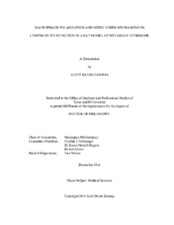| dc.contributor.advisor | Muthuchamy, Mariappan | |
| dc.creator | Zawieja, Scott D | |
| dc.date.accessioned | 2015-04-28T15:35:41Z | |
| dc.date.available | 2016-12-01T06:36:17Z | |
| dc.date.created | 2014-12 | |
| dc.date.issued | 2014-12-10 | |
| dc.date.submitted | December 2014 | |
| dc.identifier.uri | https://hdl.handle.net/1969.1/154145 | |
| dc.description.abstract | Metabolic syndrome (MetSyn) is the clustering of multiple metabolic disorders that further increase the risk for cardiovascular disease and has been recently linked to poor lymphatic function. The lymphatic system plays a crucial role in maintaining oncotic balance and returning excess fluid and macromolecules back to the blood circulation. In this dissertation we addressed the role of macrophage polarization and nitric oxide mechanisms in lymphatic dysfunction in a rat model of MetSyn. We hypothesized that mesenteric lymphatic vessel dysfunction would be associated with a polarization switch of resident macrophages after induction of peritonitis or metabolic syndrome. We used an intra-peritoneal injection of lipopolysaccharide (LPS) to simulate peritonitis in the rat and a seven-week high fructose-feeding regime to induce the MetSyn. We distinguished macrophage polarization and recruitment to the lymphatic collecting vessels using immunofluorescence and a combination of CD163, CD206, and major histocompatibility complex II (MHCII) expression. We determined the intrinsic mesenteric lymphatic contractility using the isolated mesenteric lymphatic vessel isobaric preparation. LPS-induced peritonitis increased the macrophage accumulation two fold and increased both CD163+CD206+ and CD163-CD206+ cell populations and had severely impaired lymphatic contractility. We also found evidence for a phenotype switch from CD163+MHCII- M2 macrophages to a M1 skewed CD163+MHCII+ phenotype in the MetSyn rats and impaired lymphatic contractility. Additionally, cultured lymphatic endothelial and muscle cells were found to express macrophage maturation and expansion markers in response to LPS stimulation. We also examined the role of nitric oxide in the contractile regulation of lymphatic thoracic ducts isolated from MetSyn rats. We found a reduced flow-dependent inhibition of contractility in metabolic syndrome thoracic ducts despite a normal response to the exogenous nitric oxide donor S-nitro-N-acetylpenicillamine (SNAP). The reactive oxygen species scavenging agent 4-hydroxy-2,2,6,6-tetramethylpiperidine-N-oxyl (TEMPOL) did not restore flow sensitivity, however control vessels treated with the nitric oxide synthase inhibitor L-NG-nitro arginine methyl ester (LNAME) had comparable flow inhibition to MetSyn thoracic ducts. Western blots of thoracic ducts revealed a 60% reduction in the expression of eNOS, which can explain the loss of shear sensitivity. Thus, this study demonstrates the mechanisms that underlie lymphatic dysfunction in the MetSyn. | en |
| dc.format.mimetype | application/pdf | |
| dc.language.iso | en | |
| dc.subject | Lymphatic | en |
| dc.subject | Metabolic Syndrome | en |
| dc.subject | Macrophage | en |
| dc.subject | Macrophage Polarization | en |
| dc.subject | Endothelial Dysfunction | en |
| dc.title | Macrophage Polarization And Nitric Oxide Mechanisms In Lymphatic Dysfunction In A Rat Model Of Metabolic Syndrome | en |
| dc.type | Thesis | en |
| thesis.degree.department | College of Medicine | en |
| thesis.degree.discipline | Medical Sciences | en |
| thesis.degree.grantor | Texas A & M University | en |
| thesis.degree.name | Doctor of Philosophy | en |
| thesis.degree.level | Doctoral | en |
| dc.contributor.committeeMember | Meininger, Cynthia J. | |
| dc.contributor.committeeMember | Newell-Rogers, Martha Karen | |
| dc.contributor.committeeMember | Alaniz, Robert | |
| dc.type.material | text | en |
| dc.date.updated | 2015-04-28T15:35:41Z | |
| local.embargo.terms | 2016-12-01 | |
| local.etdauthor.orcid | 0000-0003-4658-3179 | |


